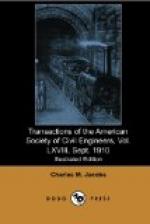The wall was designed with a stepped back, primarily to allow the water-proofing and brick protection to be held in position more readily. The first step was put at 13 ft. below the surface of the ground. This gave a vertical back above that point for a 3-in. battered face, and a slightly battered back for sections having a less batter in front. Below that point a step was added for each 5 ft. of depth to the elevation of the top of rail, or to the foundation of the wall if above that elevation. As the horizontal distance of the heel of the wall, at its greatest width, from its face at the top of rail would determine the effective room to be occupied by the wall, it was determined to make the back vertical below the top of rail and gain the necessary increase in width below that point by making a heavy batter on the face.
The type of wall having been thus determined, calculations were made of the width of base required for each 1/4-in. batter from 2 to 3 in., inclusive, first for a depth of 13 ft. below the top of the curb and then for each 5 ft. below that elevation, to a depth corresponding to the distance between the top of the curb and the top of the rail at the point of greatest variation. These widths of wall were determined for the two pressures previously decided on, and curves were then plotted showing the thickness of wall required for each batter calculated and for each pressure. They are shown on Plate LIV. The curves in broken lines represent the widths required for saturated material, and the curves in dotted lines for hydraulic pressure. Mean curves were then drawn between each broken and its corresponding dotted curve. These are shown in solid lines, and represent the widths of wall which were used in the construction. Typical sections of the wall and pipes back of it are shown on Fig. 3.
The extreme positions of the back of the wall on the two streets having been determined, as previously stated, the width of base required at those points fixed the toe of the wall at the top of rail as 254.5 ft. south of the center line of the Terminal in 31st Street, and 258.5 ft. north of the center line in 33d Street.
[Illustration:
Fig. 3.
Typical sections of retaining
wall in thirty-first street]
CONTRACTS.
The construction was done under the following contracts:
1.—The principal contract, dated June 21st, 1904, was with the New York Contracting and Trucking Company, later assigned by that company to the New York Contracting Company-Pennsylvania Terminal, for the performance of the following works:
(a).—The excavation
for and construction of a retaining wall in
Seventh Avenue, 31st Street,
Ninth Avenue, and 33d Street.
(b).—Excavation over the area enclosed by the retaining wall.




